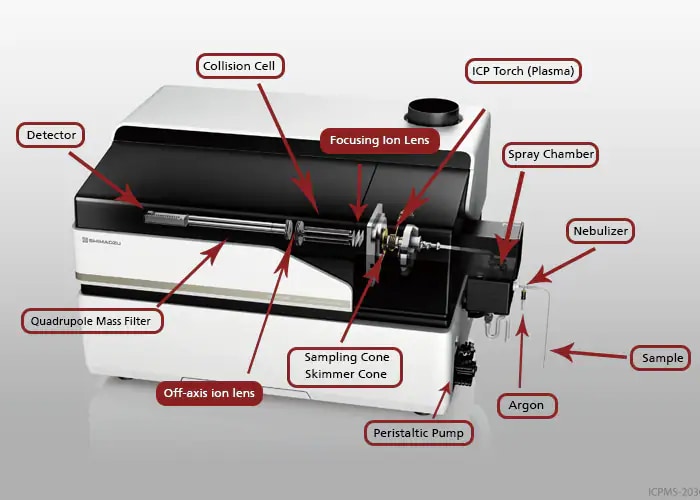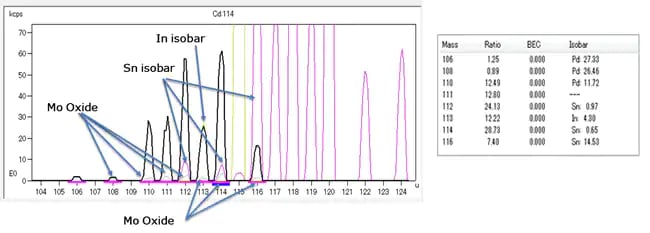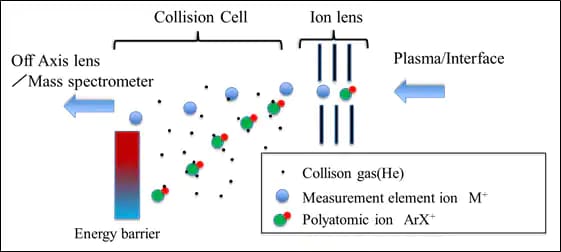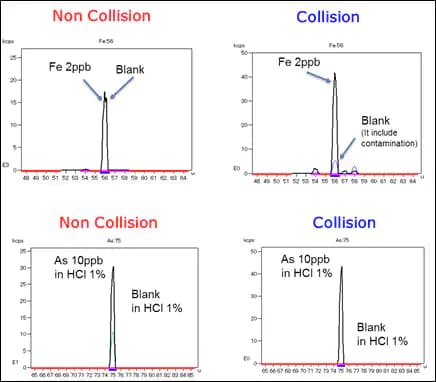Environmental Solutions
Shimadzu Inductively Coupled Plasma - Mass Spectrometry
ICP-mass spectrometry is used for measuring metals in environmental samples by EPA Method 200.8 and 6020. It can replace graphite furnace and hydride generation AA. It drastically improves your lab´s throughput because multiple elements can be analyzed in a single aspiration. As of now, all ICP-MS instruments have a horizontally oriented torch. They are limited in TDS to about 2000 mg/L. Some manufacturers claim a higher TDS tolerance, but some sort of dilution does this.

Sample introduction and plasma generation is very similar to that previously described for ICP-AES. Elements are ionized and turned into positive ions. The ions exit the plasma at the interface and pass through a lens into a vacuum. The vacuum and lenses focus the ions into a mass-selective device (quadrupole) that separates the ions based on their mass/charge ratio. A data system interprets the signals as ions hit the detector. ICP-MS can provide qualitative results, but the instrument is usually calibrated to provide both qualitative and quantitative analysis. Environmental methods target certain analytes.
Spectral interferences are caused by polyatomic ions, doubly charged ions, or other ions that have the same mass as the analyte. The effect is that a spectral interference always results from an increase in signal. This increase is independent of the target ions concentration. Physical interferences, caused by high viscosity or differences in salt content between the sample and the standards, are common in ICP-AES and ICP-MS. ICP-MS spectral interferences are different from those described for ICP-AES. In ICP-MS we are concerned with other elements or a combination of elements that have the same mass (not wavelength) as the element of interest. Physical and ionization interferences are corrected by the internal standard technique. Thus, internal standards are used with ICP-MS. Spectral interferences can be eliminated by selection of a non-interfering mass, or by use of collision or reaction cells.


A collision cell can reduce polyatomic interferences, such as the molybdenum oxide interference on cadmium. The collision cell bombards ions with helium gas, preventing the polyatomic ions from passing into the detector.

| Interferent | Mass | Element |
|---|---|---|
|
|
|
|
|
|
|
|
|
|
|
|
|
|
|
|
|
|
|
|
Examples of molecules that can cause positive interferences if there is no collision cell. Without collision cells your optional solution to pollution is dilution. Alternatively, run these elements by graphite furnace or hydride AA. For example, if chloride interference prevents you from measuring Arsenic, then you will have to measure Arsenic some other way.
Unfortunately, the collision cell is not currently approved for SDWA reporting. This requires that each sample be examined for potential spectral interferences and corrected with equations provided in Method 200.8. Fortunately, The Shimadzu Diagnosis Assistance Function will do this automatically.
Other Solutions
- Atomic Absorption
- Balances
- Energy Dispersive XRF
- Gas Chromatography
- GCMS
- Gas Chromatography Tandem Mass Spectrometry
- HPLC
- ICP/AES
- ICP/MS
- Ion Chromatography
- LCMS
- MALDI iD-Plus
- On-Line Analyzers
- Spectrophotometers
- Total Nitrogen Analyzers
- Total Organic Carbon Analyzers (TOC)
- Return to Environmental Top Page


